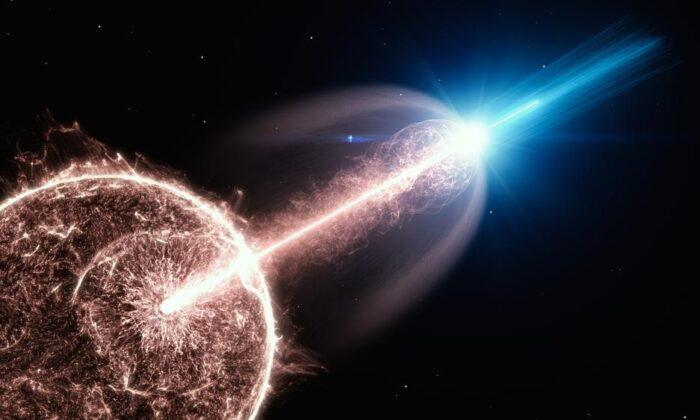A high-energy particle, thought to have been sent our way by a supermassive black hole hundreds of millions of years ago, has collided with Earth and offered astronomers a rare insight into black holes.
Supermassive black holes are behemoths hiding in the centers of galaxies. Their gravitational force is so strong that if an unlucky star gets too close to it, the star will be shredded into pieces.
Astronomers call this a tidal disruption event. The black hole then swallows the remains of the star, temporarily giving off light, as the black hole is full of energy.
Recently, a team of astronomers witnessed such a cosmic catastrophe.
On April 9, 2019, the Zwicky Transient Facility (ZTF) at Palomar Observatory in San Diego County, California, detected light emitted in a tidal disruption event.
This event, dubbed AT2019dsg, occurred in a galaxy referred to as 2MASX J20570298+1412165, which is over 690 million light-years away from Earth, in the constellation of Delphinus.
What made this event more significant was that astronomers later found a “ghost particle,” or neutrino, that came from the same direction.
On Oct. 1, 2019, the IceCube Neutrino Observatory in Antarctica detected a very high-energy neutrino called IC191001A. It turned out that the neutrino had come from a direction very close to that of AT2019dsg.
“For comparison, that’s at least ten times the maximum particle energy that can be achieved in the world’s most powerful particle accelerator, the Large Hadron Collider at the European particle physics lab CERN near Geneva.”
Neutrinos are everywhere and easily outnumber all the atoms in the universe, but they are very small and hardly interact with anything, making them extremely hard to detect. They are called ghost particles because they can pass unnoticed through solid objects.
“This is the first neutrino linked to a tidal disruption event, and it brings us valuable evidence,” said co-lead author Robert Stein, a Ph.D. student at the German Electron-Synchrotron (DESY) and Humboldt University.
Since the neutrino detection came months after the tidal disruption event, it raised questions about whether the two detections were really related.
These doubts prompted a multi-wavelength campaign using a variety of instruments such as radio, optical, and X-ray telescopes, including NASA’s Swift X-ray space telescope, to try to understand the connection between the tidal disruption event and the very high-energy neutrino.
The observations indicated that the tidal disruption event was a natural particle accelerator.
“The combined observations demonstrate the power of multi-messenger astronomy,” said co-author Marek Kowalski, head of neutrino astronomy at DESY and a professor at Humboldt University in Berlin. “Without the detection of the tidal disruption event, the neutrino would be just one of many. And without the neutrino, the observation of the tidal disruption event would be just one of many. Only through the combination could we find the accelerator and learn something new about the processes inside.”
AT2019dsg is one of only a handful of known X-ray-emitting tidal disruption events. Scientists believe that the X-rays come from either the inner part of the accretion disk or from relativistic plasma jets.
The research team did not see clear evidence of jets from AT2019dsg, and instead suggested that rapid cooling in the disk could explain the X-ray emission.
However, not everyone agrees with this idea. Another argument is that the emission came from a jet that was quickly obscured by a debris cloud. So far, it is unclear which scenario is correct.
“We might only be seeing the tip of the iceberg here,” said Professor Francis Halzen, a researcher at the University of Wisconsin-Madison and principal investigator of IceCube, who was not directly involved in the study. “In the future, we expect to find many more associations between high-energy neutrinos and their sources.”




